Length 7.29 m Introduced 1932 | Wingspan 8.94 m Retired 1959 | |
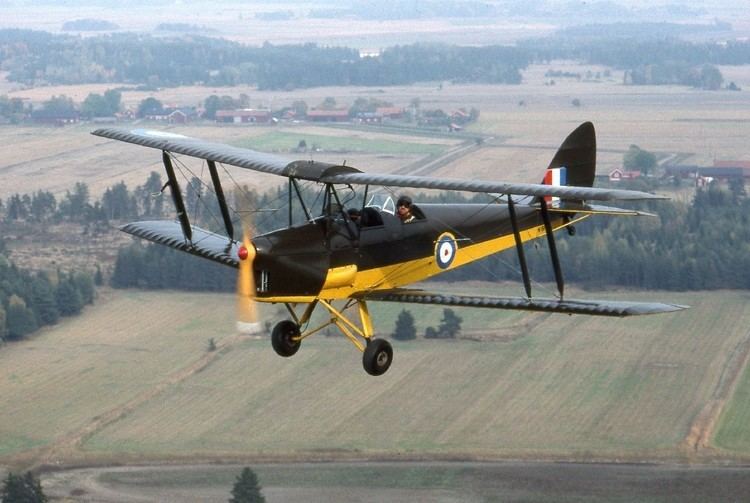 | ||
Manufacturers de Havilland, de Havilland Canada | ||
The de Havilland DH.82 Tiger Moth is a 1930s biplane designed by Geoffrey de Havilland and built by the de Havilland Aircraft Company. It was operated by the Royal Air Force (RAF) and many other operators as a primary trainer aircraft. In addition to the type's principal use for ab-initio training, the Second World War saw RAF Tiger Moth operating in other capacities, including maritime surveillance, defensive anti-invasion preparations, and even some aircraft that had been outfitted to function as armed light bombers.
Contents
- Origins
- Production
- Design
- Introduction
- Training
- Coastal patrol
- Anti invasion preparations
- Postwar
- Flying the Tiger Moth
- Variants
- Military operators
- Civil operators
- Surviving aircraft
- Specifications DH 82A
- References
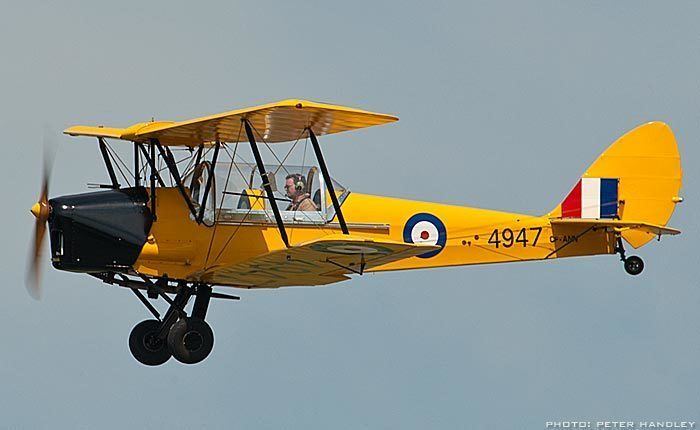
The Tiger Moth remained in service with the RAF until it was succeeded and replaced by the de Havilland Chipmunk during the early 1950s. Many of the military surplus aircraft subsequently entered into civil operation. Many nations have used the Tiger Moth in both military and civil applications, and it remains in widespread use as a recreational aircraft in several different countries. It is still occasionally used as a primary training aircraft, particularly for those pilots wanting to gain experience before moving on to other tailwheel aircraft. Many Tiger Moths are now employed by various companies offering trial lesson experiences. The de Havilland Moth club, founded 1975, is now an owners' association offering a mutual club and technical support.
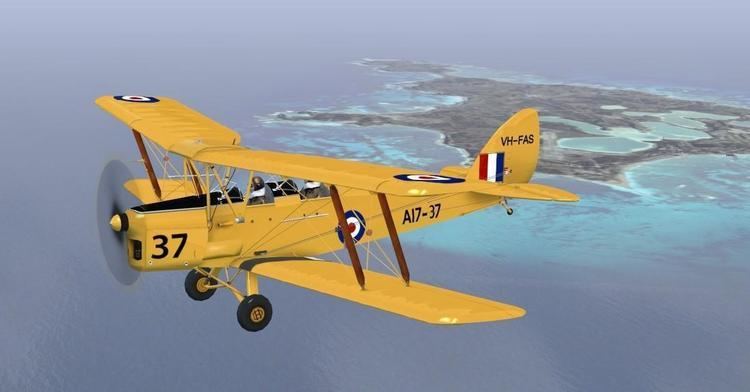
Origins

Among the reasons for which de Havilland came to pursue development of the Tiger Moth was the personal dissatisfaction of Geoffrey de Havilland, the company's owner and founder, who sought to produce a light aircraft superior to two of his previous designs, the de Havilland Humming Bird and de Havilland DH.51. From earlier experience, de Havilland knew the difficulty and importance of correctly sizing such an aircraft to appeal to various sectors of the civil market, such as touring, trainer, flying club and private aviation customers; the firm had previously attained a measure of popularity with a scaled down version of the DH.51, designated as the DH 60 de Havilland Gipsy Moth.
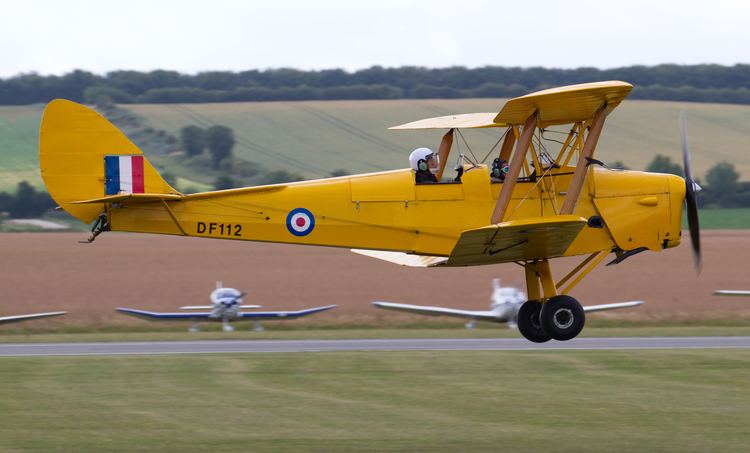
The starting point for the Tiger Moth was in fact the successful Gypsy Tiger. Successively more capable engines had been developed and the company had produced a prototype to test the new de Havilland Gipsy III engine. This prototype, a low-wing monoplane was initially a modification of the standard Gypsy Tiger; it later became the first aircraft to be referred to as the Tiger Moth. Improvements made upon the Tiger Moth monoplane were first incorporated into a military trainer variant of the de Havilland DH.60 Moth, designated as the DH.60T Moth - in later parlance, the T came to stand for 'Tiger' in addition to 'Trainer'. According to aviation author A.J. Jackson, development of the standard Tiger Moth version from the monoplane prototype had proceeded relatively straightforward after this point.
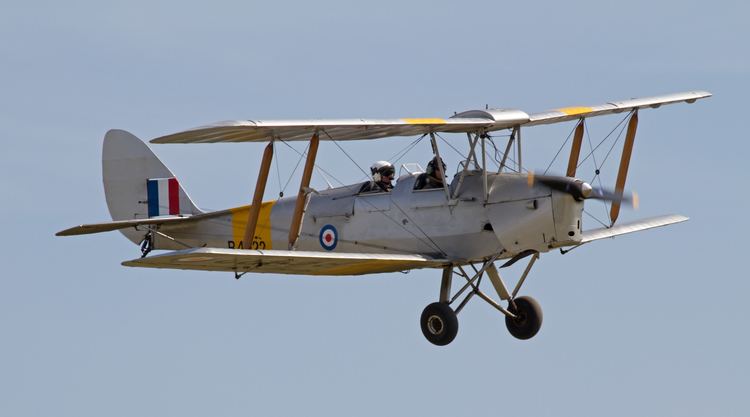
The DH.60T Moth had several shortcomings, and thus was subject to several alterations, such as the adoption of shortened interplane struts in order to raise the wingtips after insufficient ground clearance was discovered while it was undergoing trials at RAF Martlesham Heath. As a result of the Martlesham trials, a favourable report for the type was produced, which in turn led to the type soon being formally adopted as the new basic trainer of the Royal Air Force (RAF). A single prototype, designated as the DH.82 Tiger Moth, was ordered by the British Air Ministry under Specification 15/31, which sought a suitable ab-initio training aircraft.
One of the main changes made from the preceding Moth series was necessitated by a desire to improve access to the front cockpit, since the training requirement specified that the front seat occupant had to be able to escape easily, especially when wearing a parachute. Access to the front cockpit of the Moth predecessors was restricted by the proximity of the aircraft's fuel tank directly above the front cockpit and the rear cabane struts for the upper wing. The solution adopted was to shift the upper wing forward but sweep the wings back to maintain the centre of lift. Other changes included a strengthened structure, fold-down doors on both sides of the cockpit and a revised exhaust system.
On 26 October 1931, the first 'true' Tiger Moth, the prototype E6, conducted its maiden flight at Stag Lane Aerodrome, Edgware, London; de Havilland Chief Test Pilot Hubert Broad was at the controls during this first flight. Shortly thereafter, construction of the first 35 production aircraft for the RAF, designated K2567-K2601, commenced following the issuing of Specification T.23/31; in addition, two float-equipped seaplanes, S1675 and S1676, were also built according to Specification T.6/33.
Production
The Tiger Moth quickly became a commercial success, various models of the aircraft were exported to more than 25 Air Forces of various overseas nations. In addition to the military demand, aircraft were also produced for the civil market. At one point, the flow of orders for the Tiger Moth had effectively occupied almost the entirety of de Havilland's capacity to manufacture aircraft and little capacity could be spared to accommodate domestic customers. In 1932, de Havilland also developed an affordable air taxi from the Tiger Moth; using almost all of the main components of the former in combination with a new plywood fuselage seating four people in an enclosed cabin, it was marketed as the de Havilland Fox Moth. Following the end of all manufacturing, third parties would occasionally re-build Tiger Moths to a similar configuration to the Fox Moth, such as the Thruxton Jackaroo.
In late 1934, 50 Tiger Moths of a more refined design, sometimes referred to as the Tiger Moth II, were delivered to the RAF; these aircraft saw the adoption of the de Havilland Gipsy Major engine, capable of generating 130 HP, and the use of plywood decking on the rear fuselage in place of traditional fabric covering the stringers. Throughout 1334-1936, production activity was centered upon meeting the demand for military trainers, including several contracts having been placed by the RAF to Specification T.7/35 along with export orders by seven overseas operators. Civil examples were also being produced at this time, both for British private customers and to export customers in countries such as Ceylon, Greece, Lithuania, Rhodesia, Peru, and Switzerland.
After 1936, the gradual rate of acceleration of Tiger Moth manufacturing had reached the point where production capacity became finally able to exceed the demands from military customers alone. By the outbreak of the Second World War, a total of 1,424 Tiger Moths had been completed by both domestic and overseas manufacturing efforts. In 1941, de Havilland transferred principal manufacturing activity for the Tiger Moth from its Hatfield factory to Morris Motors Limited at their facility in Cowley, Oxford. In 1945, all activity on the British Tiger Moth production lines was terminated; by this point, Morris Motors had completed a total of 3,433 Tiger Moths.
In 1937, overseas manufacturing of the type commenced, the first such firm being de Havilland Canada at their facility in Downsview, Toronto, Ontario; in addition to an initial batch of 25 Tiger Moths that were built for the Royal Canadian Air Force (RCAF), the Canadian firm began building fuselages which were exported to the UK for completion. Canadian-built Tiger Moths featured modifications to better suit the local climate, along with a reinforced tail wheel, hand-operated brakes (built by Bendix Corporation), shorter undercarriage radius rods and the legs of the main landing gear legs being raked forwards as a safeguard against tipping forwards during braking. Furthermore, the cockpit had a large sliding canopy fitted along with exhaust-based heating; various alternative undercarriage arrangements were also offered. By the end of Canadian production, de Havilland Canada had manufactured a total of 1,548 of all versions, including the DH.82C and Menasco-engined variants known as the Menasco Moth; this also included 200 Tiger Moths that were built under wartime United States Army Air Forces (USAAF) Lend-Lease orders, which were designated for paperwork purposes as the PT-24, before being delivered onwards to the RCAF.
Additional overseas manufacturing activity also occurred, most of which took place during wartime. de Havilland Australia assembled an initial batch of 20 aircraft from parts sent from the United Kingdom prior to embarking on a major production campaign of their own of the DH.82A, which resulted in a total of 1,070 Tiger Moths being constructed locally in Australia. In late 1940, the first Australian-assembled Tiger Moth conducted ins first flight at Bankstown, Sydney. Most Australian aircraft were delivered to the Royal Australian Air Force (RAAF), however several batches were exported, including 18 for the USAAF and 41 for the Royal Indian Air Force (RIAF).
132 Tiger Moths were completed in New Zealand by de Havilland Aircraft of New Zealand . 23 aircraft were built in Sweden as the Sk.11 by AB Svenska Järnvägsverkstädernas Aeroplanavdelning, 91 Tiger Moths were built in Portugal by OGMA, and another 38 in Norway by Kjeller Flyfabrikk (some sources say 37 so the first may have been assembled from a kit) in addition to a large number of aircraft that were assembled from kits shipped from the UK.
Design
The de Havilland DH.82 Tiger Moth is a single-engine biplane light aircraft. It was developed principally to be used by private touring customers as well as for pilot instruction for both military and civil operators. It is typically powered by a de Havilland Gipsy III 120 hp engine; later models are often fitted with more powerful models of this engine, while some have been re-engined by third party companies.
One distinctive characteristic of the Tiger Moth design is its differential aileron control setup. The ailerons (on the lower wing only) on a Tiger Moth are operated by an externally mounted circular bellcrank, which lies flush with the lower wing's fabric undersurface covering. This circular bellcrank is rotated by metal cables and chains from the cockpit's control columns, and has the externally mounted aileron pushrod attached at a point 45° outboard and forward of the bellcrank's centre, when the ailerons are both at their neutral position. This results in an aileron control system operating, with barely any travel down at all on the wing on the outside of the turn, while the aileron on the inside travels a large amount upwards to counteract adverse yaw.
From the outset, the Tiger Moth proved to be an ideal trainer, simple and cheap to own and maintain, although control movements required a positive and sure hand as there was a slowness to control inputs. Some instructors preferred these flight characteristics because of the effect of "weeding" out the inept student pilot.
Introduction
The RAF ordered 35 dual-control Tiger Moth Is which had the company designation DH 82. A subsequent order was placed for 50 aircraft powered by the de Havilland Gipsy Major I engine (130 hp) which was the DH 82A or to the RAF Tiger Moth II. The Tiger Moth entered service at the RAF Central Flying School in February 1932. During the pre-war years increasing numbers of Tiger Moths were procured for the RAF and by overseas customers; by 1939, nearly 40 flying schools operating the type had been established, nine of which operated civil-registers models as well.
From 1937 onwards, the Tiger Moth was made available to general flying clubs, production having been previously occupied by military customers. The type was quickly used to replace older aircraft in the civil trainer capacity, such as the older de Havilland Cirrus Moth and Gipsy Moth. By the start of the Second World War, the RAF had around 500 Tiger Moths in service. In addition, nearly all civilian-opeated Tiger Moths throughout the Commonwealth were quickly impressed into their respective air forces in order to meet the strenuous wartime demand for trainer aircraft.
Training
The Tiger Moth became the foremost primary trainer throughout the Commonwealth and elsewhere. It was the principal type used in the British Commonwealth Air Training Plan where thousands of military pilots got their first taste of flight in this robust little machine. The RAF found the Tiger Moth's handling ideal for training future fighter pilots. Whilst generally docile and forgiving in the normal flight phases encountered during initial training, when used for aerobatic and formation training the Tiger Moth required definite skill and concentration to perform well — a botched manoeuvre could easily cause the aircraft to stall or spin. From 1941 onwards, all military and many civil Tiger Moths were outfitted with anti-spin strakes positioned on the junction between the fuselage and the leading edge of the tailplane, known as Mod 112; later on, the aileron mass balances were removed for improved spin recovery performance.
In 1935, a radio-controlled gunnery target version of Tiger Moth appeared, often called the DH.82 Queen Bee; it used a wooden fuselage based on that of the DH.60 Gipsy Moth (with appropriate structural changes related to cabane strut placement) with the wings of the Tiger Moth II. There were nearly 300 in service at the start of the Second World War. It is believed the name "drone" derived from "Queen Bee". These aircraft retained a normal front cockpit for test-flying or ferry flights, but had a radio-control system in the rear cockpit that operated the controls using pneumatically driven servos. Four-hundred were built by de Havilland at Hatfield, and a further 70 by Scottish Aviation.
Coastal patrol
In December 1939, owing to a shortage of maritime patrol aircraft, six flights of Tiger Moths were operated by RAF Coastal Command for surveillance flights over coastal waters, known as "scarecrow patrols". The aircraft operated in pairs and were armed only with a Very pistol. The intention was to force any encroaching U-boat to dive; one aircraft would then remain in the vicinity while the other would search for a naval patrol vessel which could be led back to the spot. Because they were not radio equipped, each aircraft also carried a pair of homing pigeons in a wicker basket to call for help in case of a forced landing at sea. A 25-pound (11.5 kilogram) bomb was sometimes carried, but there is no record of one being dropped in action.
Anti-invasion preparations
In the aftermath of Britain's disastrous campaign in France, in August 1940, three proposals for beach defence systems were put forward. 350 Tiger Moths were fitted with bomb racks to serve as light bombers as a part of Operation Banquet. A more radical conversion involved the "paraslasher", a scythe-like blade fitted to a Tiger Moth and intended to cut parachutists' canopies as they descended to earth. Flight tests proved the idea, but it was not officially adopted. The Tiger Moth was also tested as a dispenser of Paris Green rat poison for use against ground troops, with powder dispensers located under the wings.
Postwar
In the postwar climate, impressed Tiger Moths were restored to their former civil operations and owners. Accordingly, there were large numbers of surplus Tiger Moths that were made available for sale to flying clubs and individuals. There were also relatively few new light aircraft being manufactured at the time to take its place. At the same time, there were relatively due to the type being relatively inexpensive to operate and aforementioned actors, the Tiger Moth was met with an enthusiastic reception across the civil market. Additionally, it was promptly was put to use for various new roles including aerial advertising, aerial ambulance, aerobatic performer, crop duster and glider tug.
In the air racing market, a quantity of Tiger Moths were converted to a single seat configuration, often temporarily. Several aircraft were extensively modified for greater speed; these changes may include the removal of the center-section fuel tank, alternative fuel tank configurations, all-new elevators, custom-designed fuel injectors, and the re-covering of the fuselage with lighter-weight fabric. Three particular aircraft, G-APDZ, G-ANZZ, and G-ANMZ, were accordingly rebuilt and were frequently used in international competitions; the design changes led to substantially improved performance during inverted flight.
Many ex-RAF examples were imported to the Netherlands during the post war era and used to equip the Dutch National Flying School at Ypenburg. These aircraft were required by the Dutch civil aviation authorities to be fitted with a larger dorsal fin, incorporating an extended forward fillet to the fin, to provide for additional area; this requirement was also extended to privately owned Tiger Moths in the Netherlands.
The Tiger Moth might be confused at first glance with the Belgian-designed Stampe SV.4 aerobatic aircraft which had a very similar design layout; both aircraft made use of a similar main landing gear configuration, a slightly sweepback wing, and an alike engine/cowling design. Several Tiger Moths were converted during the 1950s to a Coupe standard, which involved the installation of a sliding canopy over both crew positions, not unlike the Canadian-built Fleet Finch biplane trainers which had worked beside the Tiger Moth in RCAF service as trainers in Canada during the type's wartime years.
After the development of aerial topdressing in New Zealand, large numbers of ex-Royal New Zealand Air Force Tiger Moths built in that country and in the United Kingdom were converted into agricultural aircraft; at the time, this was a pioneering use for aircraft. In this role, the front seat was commonly replaced with a hopper to hold superphosphate for aerial topdressing. A large number were also used to deploy insecticide in the crop-sprayer role, for which several alternative arrangements, including perforated piping being installed underneath the mainplanes or the placement of rotary atomisers on the lower mainplane, were used. From the mid-1950s onwards, these topdressers were gradually replaced by more modern types such as the PAC Fletcher; as such, a large number of New Zealand Tiger Moths in good flying condition were then passed to pilot owner enthusiasts.
It has been claimed that more people have flown themselves in Tiger Moths than in any other plane.
Royal Navy Tiger Moths utilised as target tugs and "air experience" machines became the last military examples when that service purchased a batch of refurbished ex-civil examples in 1956. One became the last biplane to land on an aircraft carrier (HMS Eagle) in the English Channel during the Summer of 1967. On takeoff, the wind over the deck allowed the aircraft to fly but it was slower than the carrier, which turned hard to starboard to avoid a possible collision. These planes remained in service until the early 1970s.
The Tiger Moth had been often used as a stand-in for rarer aircraft in films, sometimes having been extensively modified to outwardly resemble the aircraft it was depicting. A trio of aircraft were converted by Croydon-based Film Aviation Services Ltd for use in the filming of the 1962 movie Lawrence of Arabia; one Tiger Moth became a replica of a Fokker D.VII while two aircraft resembled the Rumpler C.V to depict these types for the film. Several Tiger Moth were used in the crash scenes in The Great Waldo Pepper, standing in for the Curtiss JN-1. Due to the popularity of the design and the rising cost of flyable examples, a number of replicas (scale and full-size) have been designed for the homebuilder, including the Fisher R-80 Tiger Moth and the RagWing RW22 Tiger Moth.
Flying the Tiger Moth
The Tiger Moth responds well to control inputs, and is fairly easy to fly for a tail-dragger. Its big "parachute" wings are very forgiving, and it stalls at a speed as slow as 25 knots with power. Its stall and spin characteristics are benign. It has some adverse yaw, and therefore requires rudder input during turns. The Tiger Moth exhibits the fundamental requirements of a training aircraft, in being "easy to fly, but difficult to fly well"; the aircraft's benign handling when within its limits make it easy for the novice to learn the basic skills of flight. At the same time techniques such as coordinated flight must be learnt and used effectively, and the aircraft will show up mishandling to an observant instructor or attentive pupil. As training progresses towards more advanced areas, especially aerobatics, the skill required on the part of a Tiger Moth pilot increases. The aircraft will not, like some training aircraft, "fly its way out of trouble" but will instead stall or spin if mishandled. However the stall and spin remain benign, again showing up deficient piloting without endangering the aircraft or the crew. These characteristics were invaluable to military operators, who must identify between pilots with the potential to go on to fly fighter aircraft, those more suited to lower-performance machines and those who must be relegated to non-pilot aircrew positions.
Because the Tiger Moth has no electrical system, it must be started by hand. This needs to be done with care to prevent being struck by the propeller, which would result in serious injury. Being a tail-dragging biplane, taxiing also requires care. The pilot cannot see directly ahead, so the lower wing can hit obstructions, and it is susceptible to gusts of wind on its inclined, large, upper wing.
The takeoff is uneventful, and it has a reasonable rate of climb. However, full power should not be maintained for more than a minute to avoid damaging the engine.
The Tiger Moth's biplane design makes it strong, and it is fully aerobatic. However, it has ailerons only on its bottom wing, which makes its rate of roll relatively slow for a biplane, and as stated previously, the ailerons on a Tiger Moth normally operate with a heavy degree of designed-in differential operation (mostly deflecting up, hardly at all downwards) to avoid adverse yaw problems in normal flight. Most manoeuvres are started at about 90 to 110 knots, and it has a Velocity Never Exceeded (VNE) of 140 knots. It is important to lock the automatic slats (leading edge flaps) during aerobatic manoeuvres.
There are two methods of landing. "Wheeler" landing involves pushing the plane on to the runway at a moderate speed with just the main wheels on the ground, with the tail held up until speed reduces. It does not tend to bounce. Unlike most tail draggers, slow speed three point landings are quite difficult because there is not enough elevator authority to bring the tail down to the correct three point attitude. This means that the tail needs to be brought down sharply at just the right speed in order for the angular momentum to carry it down sufficiently.
The open cockpit allows pilots to move their heads over the side to see the runway during approach and landing. As the aircraft is a tail dragger, it is essential to land it straight with no sideways movement, to avoid ground loops.
One often undocumented feature is that the carburetor de-icing mechanism is activated automatically when the throttle is reduced. This means that when an engine is running poorly due to ice the pilot must reduce power even further and then wait for the ice to melt.
Variants
Military operators
Civil operators
The aircraft is operated by many private individuals and flying clubs.
Surviving aircraft
Numerous examples of the Tiger Moth are still flying today (an estimated 250). The number of airworthy Tiger Moths has increased as previously neglected aircraft (or those previously only used for static display in museums) have been restored.
A number of aircraft have been preserved as museum displays (amongst others) at the:
Specifications (DH 82A)
Data from The Tiger Moth Story, The de Havilland Tiger Moth
General characteristics
Performance
Armament
8x 20 lb bombs
